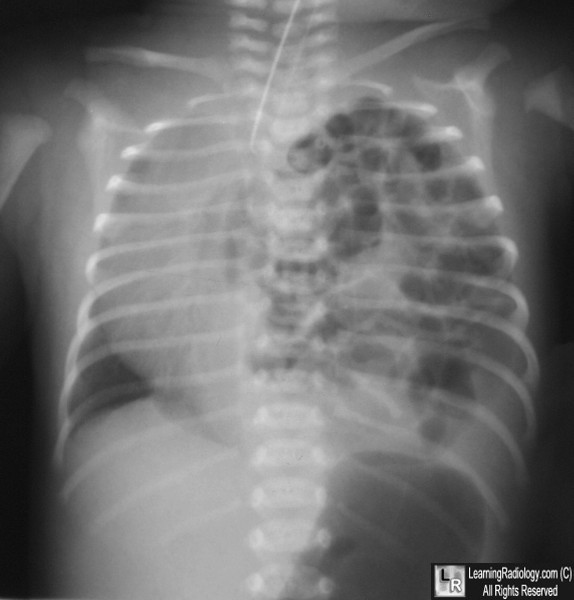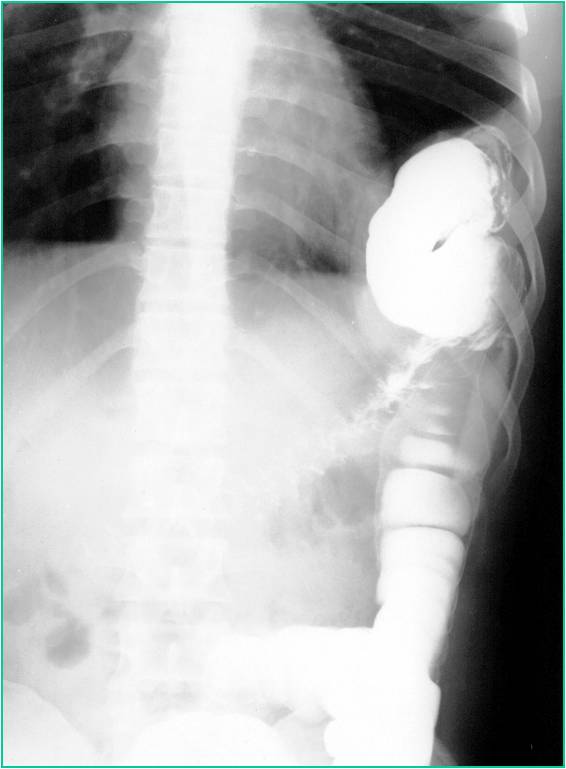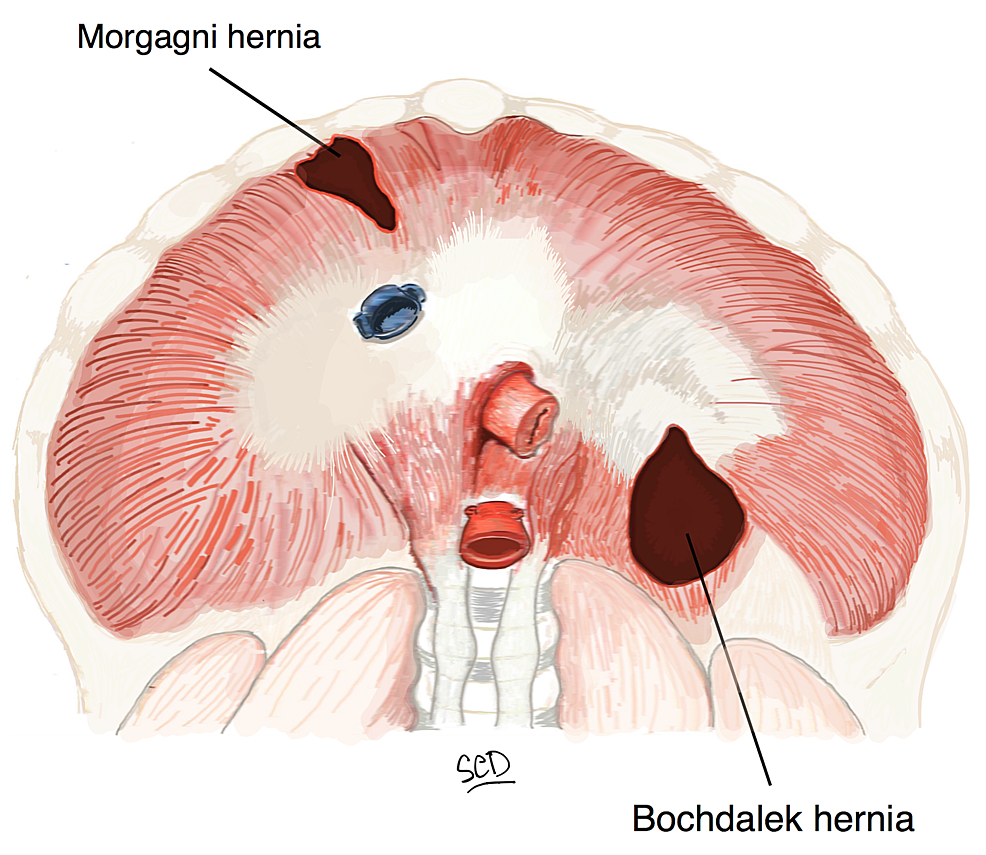
De 25+ bedste idéer inden for Pediatric radiology på Pinterest Scrubs ensartet, Nclex og
Coronal C+ portal. venous phase. Sagittal C+ portal. venous phase. CT scout image reveals indistinct right diaphragmatic copula with right paracardiac soft tissue shadow. CT images show a defect of the right crus of the diaphragm with herniation of the stomach, the first part of the duodenum and part of the left lobe of the liver into the right.

Scaphoid Abdomen Diaphragmatic Hernia A small diaphragmatic hernia is diagnosed by fluoroscopy
Bochdalek hernia is a developmental defect in the posterolateral diaphragm, allowing herniation of abdominal contents into the thorax, causing mechanical compression of the developing lung parenchyma and sometimes causing lung hypoplasia. As such, symptoms typically manifest in the pediatric age group and tend to be respiratory. Symptomatic adults are diagnosed rarely, with the majority of.

Bochdalek hernia Radiology Case
The patient was diagnosed with Bochdalek hernia based on the presence of a hernia orifice in the posterolateral aspect of the left diaphragm. When CT imaging performed 10 years before was retrospectively reviewed, a more modest degree of Bochdalek hernia was detected, which may have caused the gastric ulcer at that time (Fig. 2 ).

Bochdalek (Pleuroperitoneal) Hernia radRounds Radiology Network
Citation, DOI, disclosures and article data. Bochdalek hernias , also known as pleuroperitoneal hernias, (alternative plural: herniae) are the commonest type of congenital diaphragmatic hernia. They occur posteriorly and are due to a defect in the posterior attachment of the diaphragm when there is a failure of pleuroperitoneal membrane closure.

17 Best images about Radio Imaging Chest on Pinterest Pulmonary edema, Signs and Popcorn
If you're the kind of person who loves hosting parties where guests watch the Oscars, the Super Bowl, or the latest sitcom, putting the time and effort into creating a cozy media room, home movie theater design or custom home theater system in your Cingoli, The Marches, Italy home could be a good investment.

Álbumes 103+ Foto Fotos De Hernias En El Estómago Mirada Tensa
Bochdalek hernia is usually left sided and maybe an incidental finding in as high as 10% of asymptomatic adult 1 . As demonstrated in this case, the herniation content is usually retroperitoneal fat and less often kidney (right sided). Anteroposterior chest radiograph shows double density of right hemidiaphragm.

Rightsided Bochdalek’s hernia in an adult The American Journal of Surgery
Patient Data. Age: 20 years. Gender: Female. ct. Defect in posteromedial aspects of right hemi-diaphragm with herniation of large, small bowel and right kidney into thorax.

CT scan showing anterior left diaphragmatic hernia with small and large... Download Scientific
Posterior - Bochdalek. Most common. Occurs through old pleuroperitoneal canals. Just lateral to the spine on either side. More frequent on left side. Possibly due to "protection" of right-side by liver. Hernia may contain intestine, stomach, spleen, liver or omentum. If hernia occurs on right. Intestine and liver or only liver may herniate.

Bochdalek hernia Radiology Case
Characteristics. Congenital anomaly with defective fusion of the posterolateral pleuroperitoneal layers. 85-90% on the left, 10-15% on the right. Usually unilateral lying posteriorly within the chest. Hernia may contain fat or intra-abdominal organs. In neonates the hernia may be large and present in utero.

Chest radiograph 24 hours after repair of Bochdalek hernia. The grossly... Download Scientific
Bochdalek Hernia. More common. Occurs through old pleuroperitoneal canals. Just lateral to the spine on either side. More frequent on left side. Possibly due to "protection" of right-side by liver. Hernia may contain intestine, stomach, spleen, liver or omentum. If hernia occurs on right. Intestine and liver or only liver may herniate.
Bochdalek hernia radRounds Radiology Network
Journal of Thoracic Imaging, Vol. 24, No. 1 Prevalence of Incidental Bochdalek's Hernia in a Large Adult Population November 23, 2012 | American Journal of Roentgenology, Vol. 177, No. 2

Cureus Diaphragmatic Hernia Repair Using Biosynthetic Tissue Reinforcement Patch A Case
Bochdalek hernias are congenital diaphragmatic hernias resulting from the failure of posterolateral diaphragmatic foramina to fuse properly in utero. 1 First described by Bochdalek in 1848, 2 this entity has been almost purely a pediatric disease that generally presents with pulmonary symptoms. Radiology. 1985; 156:449-452 [Google.

Congenital diaphragmatic hernia Image
Case Discussion. Features on CT scan can be compatible with Bochdalek hernia which is a form of congenital diaphragmatic hernias. They occur posteriorly and are due to a defect in the posterior attachment of the diaphragm when there is a failure of pleuroperitoneal membrane closure in utero. Retroperitoneal structures may prolapse through the.

Pin on Excalibur Healthcare's Imaging & Teleradiology Pins
We diagnosed incidental Bochdalek's hernias in 22 patients on the basis of radiology case reviews (Figs. 1,2,3). In each instance, the patient's symptoms were not directly referable to the site of, or contents within, the hernia, and so we deemed the finding of the hernia to be incidental.
Bochdalek hernia radRounds Radiology Network
Imaging description. A Bochdalek hernia is a defect of the posterior hemidiaphragm with protrusion of abdominal content, usually fat, into the thorax [1]. It may occur on either side, but is more common on the left side due to a protective barrier effect of the liver [1, 2]. CT typically demonstrates the diaphragmatic defect with abdominal fat.

Bochdalek hernia Radiology Case Radiologic Technology, Radiology
Bochdalek hernia is one of two forms of a congenital diaphragmatic hernia, the other form being Morgagni hernia. A Bochdalek hernia is a congenital abnormality in which an opening exists in the infant's diaphragm, allowing normally intra-abdominal organs (particularly the stomach and intestines) to enter into the thoracic cavity..